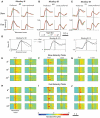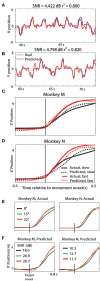Cortical correlates of fitts' law
- PMID: 22275888
- PMCID: PMC3250970
- DOI: 10.3389/fnint.2011.00085
Cortical correlates of fitts' law
Abstract
Fitts' law describes the fundamental trade-off between movement accuracy and speed: it states that the duration of reaching movements is a function of target size (TS) and distance. While Fitts' law has been extensively studied in ergonomics and has guided the design of human-computer interfaces, there have been few studies on its neuronal correlates. To elucidate sensorimotor cortical activity underlying Fitts' law, we implanted two monkeys with multielectrode arrays in the primary motor (M1) and primary somatosensory (S1) cortices. The monkeys performed reaches with a joystick-controlled cursor toward targets of different size. The reaction time (RT), movement time, and movement velocity changed with TS, and M1 and S1 activity reflected these changes. Moreover, modifications of cortical activity could not be explained by changes of movement parameters alone, but required TS as an additional parameter. Neuronal representation of TS was especially prominent during the early RT period where it influenced the slope of the firing rate rise preceding movement initiation. During the movement period, cortical activity was correlated with movement velocity. Neural decoders were applied to simultaneously decode TS and motor parameters from cortical modulations. We suggest that sensorimotor cortex activity reflects the characteristics of both the movement and the target. Classifiers that extract these parameters from cortical ensembles could improve neuroprosthetic control.
Keywords: Fitts’ law; brain–machine interface; decision making; motor cortex; neurophysiology; neuroprosthetics; sensorimotor transformation; somatosensory cortex.
Figures








Similar articles
-
Hemodynamic activity is not parsimoniously tuned to index-of-difficulty in movement with dual requirements on speed-accuracy.Front Hum Neurosci. 2024 Jul 9;18:1398601. doi: 10.3389/fnhum.2024.1398601. eCollection 2024. Front Hum Neurosci. 2024. PMID: 39045507 Free PMC article.
-
Estimation of psychomotor delay from the Fitts' law coefficients.Biol Cybern. 2009 Oct;101(4):279-96. doi: 10.1007/s00422-009-0336-3. Epub 2009 Oct 28. Biol Cybern. 2009. PMID: 19862551
-
Signal-independent noise in intracortical brain-computer interfaces causes movement time properties inconsistent with Fitts' law.J Neural Eng. 2017 Apr;14(2):026010. doi: 10.1088/1741-2552/aa5990. Epub 2017 Feb 8. J Neural Eng. 2017. PMID: 28177925 Free PMC article.
-
Predictive feedback control and Fitts' law.Biol Cybern. 2008 Mar;98(3):229-38. doi: 10.1007/s00422-007-0206-9. Epub 2008 Jan 5. Biol Cybern. 2008. PMID: 18180947
-
Motor Behavior Concepts in the Study of Balance: A Scoping Review.J Mot Behav. 2020;52(1):97-121. doi: 10.1080/00222895.2019.1582472. Epub 2019 Mar 19. J Mot Behav. 2020. PMID: 30888258
Cited by
-
Advancing brain-machine interfaces: moving beyond linear state space models.Front Syst Neurosci. 2015 Jul 28;9:108. doi: 10.3389/fnsys.2015.00108. eCollection 2015. Front Syst Neurosci. 2015. PMID: 26283932 Free PMC article.
-
Analysis of neuronal ensemble activity reveals the pitfalls and shortcomings of rotation dynamics.Sci Rep. 2019 Dec 12;9(1):18978. doi: 10.1038/s41598-019-54760-4. Sci Rep. 2019. PMID: 31831758 Free PMC article.
-
Fitts' law-based identification of motor development stages for the upper limb: proof of concept in three age groups.PeerJ. 2025 May 13;13:e19433. doi: 10.7717/peerj.19433. eCollection 2025. PeerJ. 2025. PMID: 40386241 Free PMC article.
-
Stopping is not an option: the evolution of unstoppable motion elements (primitives).J Neurophysiol. 2015 Aug;114(2):846-56. doi: 10.1152/jn.00341.2015. Epub 2015 Jun 3. J Neurophysiol. 2015. PMID: 26041827 Free PMC article.
-
Chronic, wireless recordings of large-scale brain activity in freely moving rhesus monkeys.Nat Methods. 2014 Jun;11(6):670-6. doi: 10.1038/nmeth.2936. Epub 2014 Apr 28. Nat Methods. 2014. PMID: 24776634 Free PMC article.
References
-
- Alexander G. E., Crutcher M. D. (1990). Neural representations of the target (goal) of visually guided arm movements in three motor areas of the monkey. J. Neurophysiol. 64, 164–178 - PubMed
-
- Bohan M., Longstaff M. G., Van Gemmert A. W., Rand M. K., Stelmach G. E. (2003). Effects of target height and width on 2D pointing movement duration and kinematics. Motor Control 7, 278–289 - PubMed
Grants and funding
LinkOut - more resources
Full Text Sources

